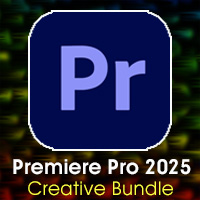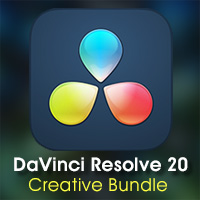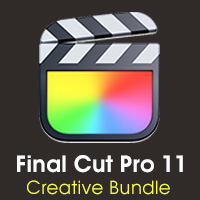"WITHOUT QUESTION!! Larry Jordan is the go to for all video editing & more! Mr. Jordan has decades of experience and knows what we need. He’s not only teaching software, Larry teaches knowledge & experience: Wisdom!" - Oscar Bustamante, Fluid Vision Inc.
Featured Products
-
Sale!

Creative Bundle: Adobe Premiere Pro 2025
Original price was: $117.73.$74.29Current price is: $74.29. Select -

Larry Jordan Gift Card
Select -
Sale!

Creative Bundle: DaVinci Resolve 20
Original price was: $119.70.$79.99Current price is: $79.99. Select -
Sale!

Creative Bundle: Apple Final Cut Pro 11
Original price was: $132.71.$88.92Current price is: $88.92. Select
COLLECTION
The latest update to Final Cut Pro X contains dozens of new features, including media management, import and export, effects, and much more. Get the latest training for a VERY SPECIAL PRICE!
Apple Motion intimidates a lot of editors, but it shouldn’t. We can use Motion to easily create fascinating effects without requiring the programming skills of a rocket scientist or the design skills of a graphic artist. In fact, creating motion graphics to add life to your projects is pretty simple; if you know how.
Shooting with multiple cameras is increasingly common, especially for performances and sports. However, editing multiple cameras – called “multicam editing” – can be challenging, especially as the number of cameras you are editing increases.
The media world is not yet ready to abandon optical media. In fact, many editors depend upon DVD or Blu-ray Disc sales for a large portion of their income. But the world HAS moved from the standard-definition world of DVD to the high-definition world of Blu-ray Disc.
Blend modes, which Final Cut Pro 7 called “composite modes,” combine images based upon their gray-scale or color values. Which sounds weird until you start to play with it. Think of blend modes as “sharing textures between images.” What makes blend modes so exciting is that they are easy to apply, yet open up a world of creative possibilities.
Text is critical to video projects today. Many of us create titles in Photoshop, but one of the very cool features inside Premiere Pro CC is its built-in titler. In fact, you can do things with titles in Premiere that you can’t do in Photoshop! In this one-hour online webinar you’ll learn how to put Premiere’s Titler to work in your projects.
Color correction fixes mistakes. Color grading uses color to enhance the emotion of your story. In this one-hour video training, discover how the color effects, third-party filters and Color Board inside Final Cut Pro X can reinforce and emphasize the story you're creating.
A BRAND-NEW MOUSEPAD FOR FINAL CUT PRO X 10.1! All New Design – More Keyboard Shortcuts Than Ever! Can you answer these questions: What do I put under my mouse? Where can I go to find keyboard shortcuts when it’s …
One of the features that makes Final Cut Pro X so exciting isn't even created by Apple. It's the thousands of third-party plug-ins and applications that work with Final Cut. These add effects and capabilities far beyond the basics shipped with the software.
All effects in Final Cut Pro X are first created in Motion 5, then saved so that Final Cut can use them. This is great news for anyone wanting to create custom Final Cut effects. Except… how? Even worse, what if you can’t draw a straight line without mechanical assistance?
The most powerful, yet confusing, new feature in Final Cut Pro X, v.10.1, is media management. The new library, event, and project structure is a big change from earlier versions of Final Cut. This video tutorial takes you inside the application and gives you an in-depth look at how the new media management system works.
The latest update to Apple Compressor â 4.1 â brings with it a whole new interface, faster performance, more compression presets, and a different way to monitor your work. Join host Larry Jordan as he explores the latest features in this software and shows you how to put them to work in your projects.
Apple just released its latest update to Final Cut Pro X and this webinar gives you a first look at all the new features. We designed this webinar for those that need more than YouTube, but don't yet want to invest in full-on training. The latest update to Final Cut Pro X sports more than 200 new features; including a totally revised system for media management. This webinar provides an in-depth look at many of them, including several existing features that you may not already know about.
COLLECTION
Join Master Trainer Larry Jordan as he takes you step-by-step through the latest version – 4.1 – of Apple Compressor. This training, which is designed for both beginning and experienced users, starts by explaining terms and concepts to build a firm foundation for the rest of this training. Then, Larry illustrates virtually every feature in the program – from simple settings to full-on automation – that Compressor offers to simplify your compression tasks.
As more and more video goes to the web, the quality of our video compression has a direct bearing on the results of all our editing. It is critical that we make our compressed videos look great – whether for YouTube, DVD, or the web. However, figuring out how to make compressed video look great is a bigger challenge than you might expect.
One of the exciting things in every update is discovering all the latest features. And, in the 7.1 update to Premiere Pro, Adobe has added a TON of new stuff. From improved performance, to direct links to SpeedGrade, to improved multi-camera sequences, to a whole host of smaller features. Some are calling this Adobe’s most feature-rich update since the initial release of the Creative Cloud software.
Editing tells the story, but effects add life, energy, and just plain fun to any edit. And, with Final Cut Pro X, there are literally thousands of different effects to choose from; especially when you expand beyond those bundled with the applications itself. This video training looks at 16 different effects plug-ins, from 9 different developers, that can make your projects stand out from the crowd.
All the technical skills in the world won't pay the bills if you can't find a job. That's where this webinar can help. Whether you are just getting started or looking for work – yet again – this webinar is filled with tips you can use today.
Based on all the questions we get every day in our email, lots of folks find media management in Final Cut Pro X confusing. So, this webinar is designed to provide a foundation for organizing, importing, tracking, finding, and managing media, Events, and Projects in FCP X.
Final Cut Pro X provides a solid foundation for editing your video. And, since Apple added the ability to export detailed project information using XML, things really took off. In this video webinar, host Larry Jordan shows you how to use nine different utilities that can take your Final Cut Pro X projects to entirely new levels.
COLLECTION
Today, everything we create ends up on the web. This means that if we don't know how to compress our media to make our images look good on the web, all the work during production and editing will be wasted. To make matters worse, compressing video for the web seems like rocket science.
Increasingly, the web is the final destination for all our work. Whether we are posting to YouTube, Vimeo, or a corporate website, the quality of our projects is increasingly determined by the quality of our video compression. Whether you are working in Adobe Premiere Pro, After Effects, Prelude, Encore, or simply compressing video from other sources, Adobe Media Encoder is central to your work.
Sometimes our webinars have a plot; but not this one. This session is more like a cookbook – a whole flock of unrelated recipes you can use to create moving text, backgrounds, foregrounds, mid-grounds – we’ve got grounds for some seriously fascinating new effects that are fast and easy to create.
A keyframe is a point of change during playback. If nothing changes, then you never use keyframes. When you need something to change â like an audio level, or the position of text â we use keyframes. And we always use keyframes in pairs; a starting position and an ending position.
Learning video editing is more than just learning Premiere. Included with the CS6 release of Adobe Premiere Pro is a wealth of other software than can make your editing life easier. But learning how to use it isn't easy – good training is hard to find. In this collection of in-depth webinars, we show you how all this software works — quickly, easily, and in-depth.
Color correction is an endlessly fascinating subject and one of our most popular webinars. With the latest release of Adobe Premiere Pro CC, its time to revisit the process of making your images look great. There are three ways to modify the look of your images, and this session covers all of them.
COLLECTION
Video engages the mind. Audio captures the heart. The best thing you can do to improve the quality of your pictures is to improve the quality of your sound. And nothing does that better than Adobe Audition CC. Whether you edit with Adobe Premiere Pro, Apple Final Cut Pro, Avid Media Composer, or other video editing software, you can use Adobe Audition for your projects.
COLLECTION
Video engages the mind. Audio captures the heart. The best thing you can do to improve the quality of your pictures is to improve the quality of your sound. And nothing does that better than Adobe Audition CC. Whether you edit with Adobe Premiere Pro, Apple Final Cut Pro, Avid Media Composer, or other video editing software, you can use Adobe Audition for your projects.
“Ingest” is the process of converting tapeless media into something your computer can edit. And the new Adobe Prelude CC is the latest tool to use for ingest â whether into Premiere Pro CC, Premiere Pro CS6, or Final Cut Pro 7. Another benefit to Prelude is that it can be run by a less experienced editor as a way to screen clips before moving them into the editing suite.
In this session, hosted by Larry Jordan, weâll take a first look at this recharged application. Part training, part guided tour, take a look at the new features and see how they build on the feature-rich power of the CS6 release. This is a great time to watch, ask questions, and kick the tires before deciding whether to upgrade.
In past webinars, we talked about how to read the video scopes and use the color correction tools. This is a great way to learn how the color correction technology in Final Cut Pro X works. But it doesn’t provide a lot of help when you are trying to create a “look” for a scene, or trying to get a bunch of different clips to match.
Sometimes, when production goes perfectly right, we can do our entire sound mix in Adobe Premiere Pro, or Apple Final Cut Pro. But how often is the audio we record on set “perfect?” For those situations where you need to fix problem audio, Adobe Audition can come to the rescue. And showing how that works is what this session is about.
Plug-ins are small pieces of software that are added into an editing application that allow it to do stuff that the editing application can’t do natively. The success of any editing software is often directly dependent upon the number and kinds of plug-ins that are available for it.
This intermediate-level video training is designed for editors who want better control, or more options, when editing audio in Final Cut Pro X. Join host, Larry Jordan, as he illustrates advanced audio editing and mixing techniques that can speed up and simplify your editing.
This video training is designed for editors who understand the fundamentals of video compression, but want to do more, work faster, or push the software further.
Whether you want titles which are clean and simple, or highly formatted and animated, you can create them in Final Cut Pro X. In this online video training, join master trainer, Larry Jordan, as he shows you how to create both simple and complex titles in FCP X. Learn how the formatting tools work, how to modify animation parameters, and how to use the âhidden-in-plain-sightâ formatting styles toolbar.

